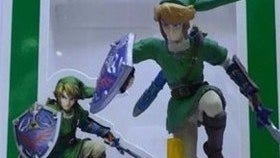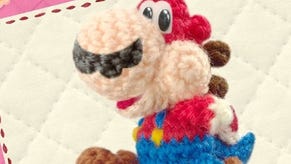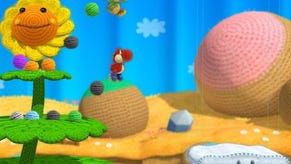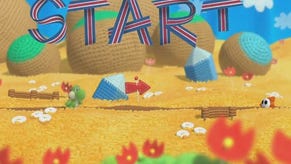Yoshi's Woolly World review
Sew-sew.
One of the many things that Nintendo has fatally warped my understanding of is yellowcake, the milled form of uranium oxide that marks a crucial step in the business of processing uranium ore. That's back in the real world, anyway. To me, alas, yellowcake will always look and behave like the material you get in some of the levels of Yoshi's Island: the brittle, golden, biscuity kind of rock that you can bore holes through by chucking an egg or by ramming with your snout. No Geiger counters needed, but would it kill you to wear a hardhat?
The more I think about Yoshi's Island, a 2D platformer in which Mario lets his dinosaur pal take the limelight for once, the more I realise it was defined by this stuff - or rather, by stuff in general. The fun emerged from the different materials that Nintendo relied on to make each new level delightful and surprising, the different materials that forced you to create parts of your own lexicon, like yellowcake. Everyone remembers the papercraft butterflies that flittered through the pastel skies overhead as you relayed your baby Mario and baby Luigi through ingenious 2D stages, but alongside them and alongside yellowcake, there was that sticky goop you could get your head stuck in, there were fat, sagging balloons, and there were the mines - those mines! - the walls made of razor sharp crystals and riddled with bouncy balls that would propel you from one impromptu playroom to the next, where something entirely novel no doubt awaited you.
This, I suspect, is a small part of why I've found myself getting a little bored by a game that ostensibly takes up the mantle of Yoshi's Island and brings it into the HD era. Yoshi's Woolly World is a beautiful game in which almost everything you interact with is made of thick, hairy yarn. It's also a game, though, in which almost everything you interact with is made of thick hairy yarn. Prettiness isn't the problem here. Cleverness isn't the problem here either, because there are a few lovely design moments scattered across the campaign. The problem is variety. At a superficial level at least, Woolly World is a victim of its own gorgeous, eye-catching conceit, of its central material preoccupation.
At times, it's a truly wonderful conceit, mind. Yoshi looks great, thick stitchwork covering his head and body and transforming his feet into spinning crochets when he picks up speed. Equally, the enemies he grabs with his tongue and transforms into ranged weapons become balls of wool rather than eggs, and the levels are riots of handicraft imagination, bosses ducking behind blankets in between attack waves, Shyguys advancing wielding knitting needles, sand-dunes formed by rippling scarves and lone threads projected from cave walls, tempting you to unravel them and discover their secrets. Even the plot, such as it is, revolves around wool, with your fellow Yoshis reduced to balls of yarn and scattered across six gloriously colourful tabletop worlds, all of which deliver their platforming staples - desert worlds, ice worlds - with visible stitching. And it fits, too. The lineage works. Back in the 1990s, the original Yoshi's Island squared up against the sheeny 3D glossiness of Rare's Donkey Kong with a game that looked like it was made of paper. Paper! The audacity! The shock of the old.
So looking beneath the wool, why else does Woolly World fall a little flat? Mostly, I suspect, because I still remember Yoshi's Island itself with such clarity. Woolly World, behind its joyous pincushion surfaces, is one of the most conservative sequels Nintendo has ever released, and in its attempt to recreate the feel of Yoshi's Island right down to the majority of its collectables and the way it likes to frame its boss fights, it has somehow forgotten that the defining feature of the earlier game wasn't the structure or even the central mechanics that blended platforming with something that felt like shooting - or at least billiards - as you augmented the ground-pound and flutter-jump with the ability to lob eggs at distant foes. Rather, it was the Yellowcake Mentality: It was the fact that every level you unlocked gave you something new: Chain Comps that zoomed in from the horizon before dropping directly onto you, rivers where the water would grow lumpy - and would then grow eyes and a mouth and would lunge at you. Yoshi's Island was a game you played in a constant sense of glorious panic, almost overwhelmed by what was going on and desperately curious as to what would come next - because for one of the first times in a platform game, it genuinely could have been anything.
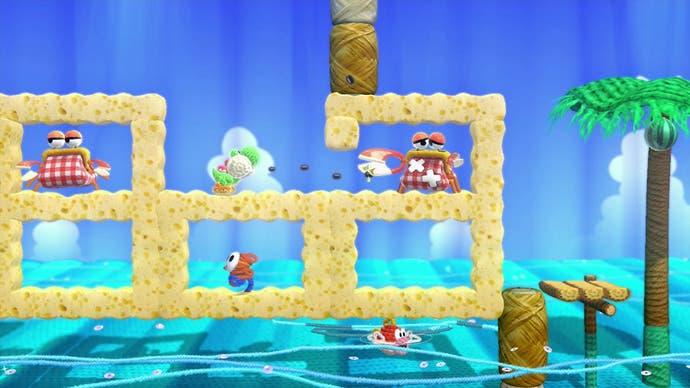
Woolly World aspires to that kind of scattershot invention, but when it throws its gimmicks at you, they're too often the same gimmicks as last time. The world of ghost blocks you have to trigger to life with the flick of a switch, the Shyguys on stilts, the watermelons that allow you to spit pips like you're a weird artisan machine gun. Even when Woolly World leaves memories of the Island behind, it tends to borrow from close relatives: Mario's grates that allow you to flip between planes at regular junctures, his shadow-puppet theatres and ghost houses. There are a few new ideas here, such as collapsing clouds of cotton wool that you can trigger or climb, a chain chomp rampage, or a glorious piranha plant boss fight that feels like a Busby Berkeley number, but they are outweighed by the borrowings and the cribs.
All Nintendo games share elements, of course, but what makes Woolly World a little dull is its unwillingness to repurpose old ideas in new ways - or in new ways that go beyond rendering them out of yarn. I can't think of much that this game's truly adding to the canon, and it's been a while since a Nintendo title has left me feeling that.
Should this matter? You could argue it shouldn't, particularly when local two-player co-op is such a riot, gifting you the ability to grab your ally and turn them into a ball of wool to chuck about and bringing crazy energy to even the most rote of levels. Particularly when the true audience for this game presumably isn't a 37-year-old but a 7-year-old, who doesn't have all those memories of the original Yoshi's Island to show this project up so regularly and to underline the sense that the developers Good-Feel are custodians rather than trailblazers.
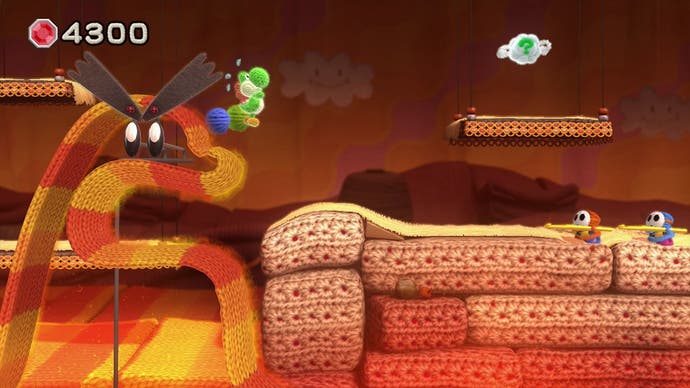
If any game really explored the quandary Nintendo's in these days, come to think of it, this is probably it: shackled with two audiences, one of whom has forgotten nothing and will demand a strange and contradictory blend of nostalgia and innovation at all times, and one of whom is coming to everything completely cold - but is at least as interested in Minecraft as Mario and rightly so. Ultimately, even those 7-year-olds would probably be better served by just tracking down the original Yoshi's Island, on one of the many platforms that preserves it. The level design's better, although Woolly World, granted, has a nice mixture of straight-ahead left-to-rights and more complex, dungeony areas, even mixing in a few palate cleansers where Yoshi transforms into a plane, into an umbrella, into a giant, to great effect.
Tellingly, I think the graphical approach is better, too. For all Woolly World's cuddly invention, there was such imagination and range in the spritework of the original, a real energy coming from this spot it found itself in historically, navigating a technological landscape that was slowly starting to shift from 2D to 3D.
And finally, of course, there's the panic. Yoshi's Island wasn't just a game about getting to the final goal, but about transporting a couple of babies there safely with you. That sense of noble fragility is so hardwired into the design that, every time I took a hit in Woolly World, I would find myself instinctively turning about-face and extending Yoshi's tongue to grab at a departing bubble-baby that simply no longer exists in this version. Good-Feel's doing all the carrying this time, and maybe it's so desperate not to drop anything that it's forgotten to take any risks.
A bad game, then? Not at all. Most of the time it's quite a good one. But Woolly World sails perilously close to a genuinely great game, and with little of its own to add, it can only ever feel diminished by the proximity.



